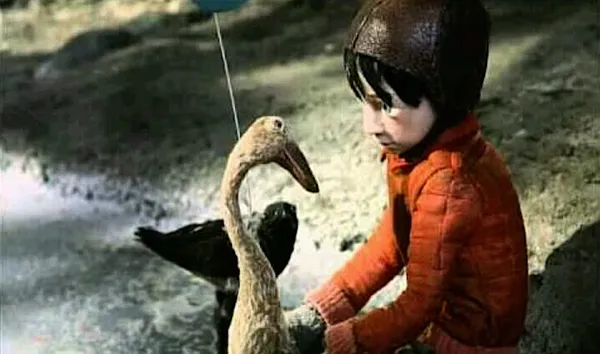 |
| Wes Anderson selected Suzie Templeton’s Oscar-winning Peter & The Wolf to screen in the Animation First Festival in New York |
Suzie Templeton’s 2008 Oscar-winning Animated Short Peter & The Wolf (co-written with Marianela Maldonado, based on the libretto by Sergei Prokofiev, produced by Hugh Welchman) is a timeless masterpiece. Selected by Wes Anderson (his Isle Of Dogs with the voices of Bryan Cranston, Jeff Goldblum, Koyu Rankin, Greta Gerwig, Scarlett Johansson, Bill Murray, Yoko Ono, Edward Norton, Bob Balaban, and Frances McDormand, has been added for this weekend), the first American Special Guest at the French Institute Alliance Française fourth annual Animation First Festival in New York it screens along with three other animated films that inspired him: David Hand’s Bambi (Disney, 1942), and two shorts, Martin Rosen’s The Plague Dogs (1982) and Garry Trudeau’s A Doonesbury Special (1977), co-directed by Faith Hubley and John Hubley. Templeton’s short Dog won Best New British Animation at the Edinburgh International Film Festival in 2001 and the Best Short Animation BAFTA in 2002.
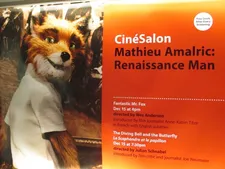 |
| Mathieu Amalric: Renaissance Man poster featuring Fantastic Mr. Fox and Julian Schnabel's The Diving Bell And The Butterfly Photo: Anne-Katrin Titze |
Suzie from snow-covered Amsterdam joined me in snow-covered New York for a conversation over Zoom on Peter & the Wolf, which stars a runner duck, a hooded crow, a lone wolf, Peter, and grandfather with his grumpy cat in glorious stop-motion cinematography.
Anne-Katrin Titze: For the Animation program at FI:AF, Wes Anderson picked your film as one of his all-time favourites.
Suzie Templeton: Amazing!
AKT: Did you ever talk with him about your film?
ST: I’ve never met him face-to-face, but we have been in touch a little bit on e-mail because we wanted to meet up and didn’t manage to. And then he came to a performance of Peter & the Wolf but I couldn’t make it. So I didn’t actually meet him.
AKT: Do you have a favourite Wes Anderson movie? To turn it around.
ST: Well, of course the first one that pops into my mind is Fantastic Mr. Fox.
AKT: I introduced a screening of Fantastic Mr. Fox at FI:AF. Mathieu Amalric was the French voice of Mr. Fox.
ST: It’s such a wonderful film. Actually, I always loved the story from when I was a child.
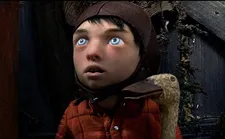 |
| Suzie Templeton on Wes Anderson: “He came to a performance of Peter & the Wolf …” |
AKT: The Roald Dahl story.
ST: Yes, and I was so excited when I heard that he was going to make it and what would he do with it? And then when he came out with that, which was so unexpected. To make something like that out of the little book! It was just wonderful. I also love his earlier things like [The Life Aquatic with] Steve Zissou. They’re all fantastic, aren’t they?
AKT: They are. I love them all. What you did with Peter & the Wolf is so unusual. Prokofiev himself reinvented storytelling by having instruments and a narrator. And then you took the tale and changed it again by taking away the narration and adding the stop-motion visuals. It’s like another turn of the screw. How did you have the idea to do this?
ST: Well actually, I did really doubt it, doubt the concept of doing that. For me the magic of that piece is inside your head. It’s in what you see. But you have just a couple of lines of narration and hear the music and imagine what you’ve just been told. And you build on it yourself in your mind. So my big doubt about doing this film was that it would take away the magic. It would be too literal to see it on the screen. Actually in the first stages of writing the script, I had dialogue.
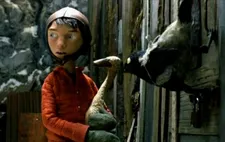 |
| Suzie Templeton on Peter: “The bird and the duck are aspects of him that he brings to himself by the end. |
AKT: Oh wow! Did you have the animals speak? Did the duck talk? Or just the people?
ST: I literally can’t remember. I think it was just the people. It was such a long time ago. But I’m so glad we dropped the dialogue because it’s still being performed now. There was one very recently in South Korea.
AKT: You completely avoid the language dilemma.
ST: One of our original concepts was live foley. As well as the orchestra, there would be some foley artists performing live for the children.
AKT: The wind and the gate etc?
ST: It wasn’t financially viable to do it like that. At the moment there’s a recorded soundtrack which goes along with the orchestra. We would have loved to have done that live.
AKT: When a tale is told to you and you imagine it in your head, it’s different. Having visuals can make it more drastic, more violent.
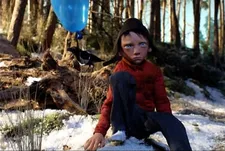 |
| Suzie Templeton on Peter’s red jacket: “I pictured it just because it was so beautiful against the background of snow.” |
ST: And also with this piece especially, because everybody has already imagined it, they have their own vision of what it should be like. So when they’re confronted by somebody else’s vision of what it could be like, that can be quite shocking and offensive to some people, actually. Not just the violence. But there is a little bit more violence than I was intending in the film. But just in the way that Peter looks or in the way that the bird looks or the duck looks. People say, he’s not supposed to look like that!
AKT: Or the fact that you chose snow. It’s not necessarily winter in the other versions.
ST: Exactly, a different season.
AKT: The duck is swimming on the pond, not skating.
ST: That’s quite confronting for people.
AKT: I adore the duck! Every time I see your film I am so in love with this runner duck. I’m a licensed wildlife rehabilitator, and I have worked a lot with ducks and swans. Peter is a bit like a wildlife rehabilitator in his actions. The movements are so perfect, the preening, the “duck kisses” they are all so natural. Did you work with ducks on this?
ST: I visited a sweet boy who had ducks, maybe six runner ducks as pets.
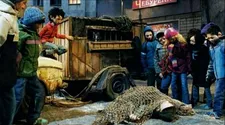 |
| Suzie Templeton: “I wanted Peter to be a hero.” |
AKT: Where was that?
ST: That was in England. And we filmed him interacting with his ducks.
AKT: The dystopian quality of Peter & the Wolf is interesting. On the one hand it goes back in time to a Soviet era and at the same time we may wonder if this is our future. Especially seeing it again now during Covid.
ST: I wanted it to feel timeless but in a way that you wouldn’t question it. I didn’t want you to continuously think - When is this? What’s going on? I just wanted it to feel timeless, just like a tale. It is set in the current time but I wanted to underplay that so that it didn’t become an issue.
AKT: The red jacket for Peter makes you think of all the red riding hoods in tales.
ST: I pictured it just because it was so beautiful against the background of snow.
AKT: He has this little pilot cap and the wolf - these are classic tropes. I love how you switched the ending. The wolf isn’t put in a zoo but you have him run towards the moon. Can you talk a bit about the ending and your decision-making?
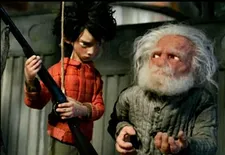 |
| Suzie Templeton on Peter and his grandfather: “He is now the grown-up. He is the adult, he takes charge.” |
ST: Well, I wanted Peter to be a hero. A hero to me. And to me he is a boy who discovers his strength. And he conquers all of these forces around him, forces of corruption. He is now the grown-up. He is the adult, he takes charge. His belief and his heroism is in seeing that the animal has its own value. Not the value that we place on it, but its own value. That’s the hero to me.
AKT: And he realizes that his grandfather is not that heroic.
ST: I see that as a rite of passage.
AKT: Another decision of departure was to have the bird have a broken wing and give him a balloon. Where did that come from?
ST: We’re going back a very long way. I think I wanted to create a lovely scene of him helping the bird, when he has all that time out there with the bird and the duck. I wanted them to really have something to achieve. And at the end the bird is helped. I see that as aspects of him. The bird and the duck are aspects of him that he brings to himself by the end. And the wolf also.
AKT: That is the folktale quality. Animals tell us so much about humans and human interactions. Claude Lévi-Strauss said “Animals are good to think with.” Which makes a lot of sense to me.
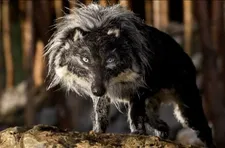 |
| Suzie Templeton on Peter and the wolf: “His belief and his heroism is in seeing that the animal has its own value.” |
ST: In Dutch there is something called a “Sprechhund”, literally a speak dog. It’s a device in storytelling where you use an animal to speak to. It’s any animal you can use to express what you want to in the storytelling. When you need to express something verbally and you need someone to express it to. Often that is an animal because you don’t want it to speak back.
AKT: You captured so well the human/animal interactions. The cat’s reactions, the bird’s reactions - you are not going for the cartoonish side so much.
ST: I wanted them to be animals, but also to be very relatable, to be very understandable. Sometimes we’re left outside of animals. By the reality of animals we are left on the outside. I think that’s why animation, Disney, for example, is so popular, because suddenly we are able to understand the animal. You relate to the animal. And I wanted to achieve that but to keep them more on the animal side.
AKT: It’s the balance that you capture between something really adorable that we can understand and at the same time it’s still the animal and the other. Speaking of Disney, Prokofiev went to Hollywood to meet Disney for his Peter & the Wolf version after WWII. Disney’s Bambi is another choice by Wes Anderson, besides your film. The scene on the ice with Bambi and Thumper - were they an inspiration for your scenes on the ice?
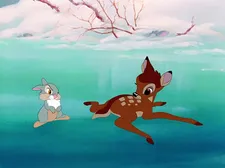 |
| Suzie Templeton: “I always have been really inspired by Bambi but I’ve never really thought about it in relation to Peter & the Wolf.” |
ST: It’s so interesting you say that, because I always have been really inspired by Bambi but I’ve never really thought about it in relation to Peter & the Wolf. But I remember an interview at the Academy [AMPAS]. It was in this big, big auditorium and somebody asked me what was my most inspiring film. And I did pick Bambi in that moment. I was so overwhelmed by the whole thing. I’ve never really thought about it in that context. I saw Bambi very young and I was very very shocked by it. I think it’s always been there.
AKT: For me too. It is etched in my head and memorable. That is the basic point about animation and tales in general. They only work if they are somewhat disturbing. If they are too smooth, we, as children and adults, forget them.
ST: Watching films with the kids when they were really little - they would love to watch everything, but the more superficial stories they were happy to watch once, but they never wanted to watch them again. It was always the deeper stories, the ones with disturbing elements, as you were saying, that they wanted to watch again because they needed to work it out.
AKT: That’s why fairy tales survived thousands of years - people were disturbed by them and wanted to hear them over and over again. I think that is also why your film has become a classic. It touches something deep inside.
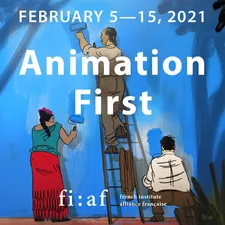 |
| Animation First Festival at the French Institute Alliance Française in New York |
ST: Thank you. I hope that’s true, because that’s what we were hoping to achieve. Something to endure.
Wes Anderson’s selected shorts Peter & The Wolf, The Plague Dogs, A Doonesbury Special will screen virtually in the US throughout the French Institute Alliance Française Animation First Festival in New York.
Bambi to screen virtually in French or Hindi with English subtitles from Friday, February 12 at 6:00pm to Sunday, February 14 at 6:00pm. Isle of Dogs will screen starting tonight till Sunday, February 14 at 6:00pm.
Rémi Chayé’s Calamity, A Childhood Of Martha Jane Cannary (Calamity, Une Enfance De Martha Jane Cannary) returns for the final weekend of the Animation First Festival through Monday, February 15.
The French Institute Alliance Française Animation First Festival in New York, co-curated by Delphine Selles-Alvarez and Catherine Lamairesse, runs through Monday, February 15.





















